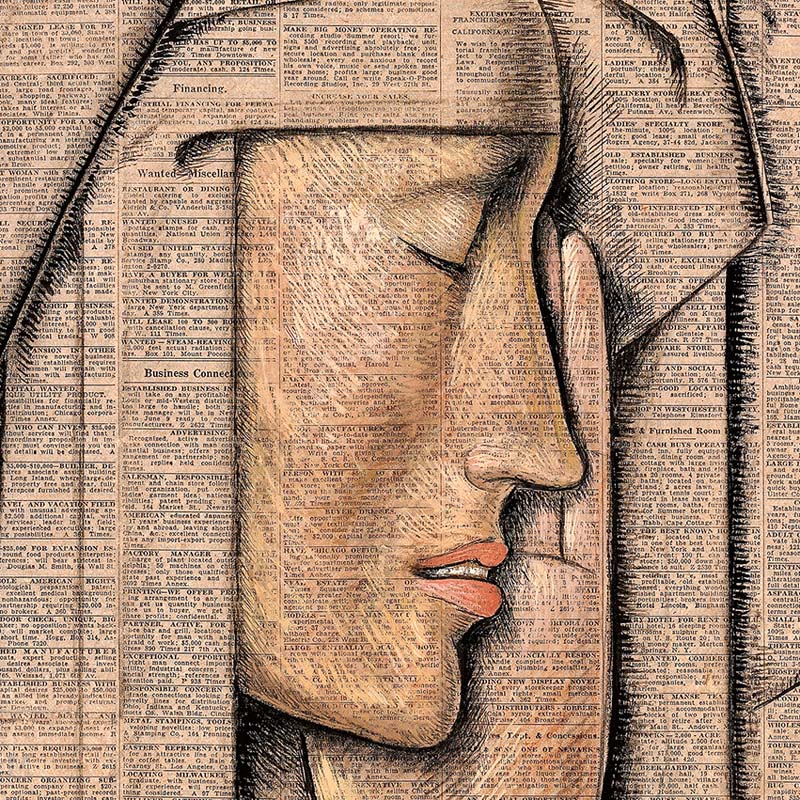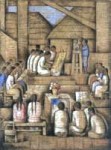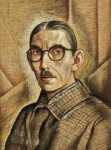

Alfredo Ramos Martinez
Mexican, 1871-1946 (active Mexico, United States, France)
La escuela (The School), 1937
gouache, charcoal and watercolor on newsprint
21 3/4 x 16 3/8 in.
SBMA, Gift of P.D. McMillan Land Company
1963.30

Self-portrait of Ramos Martinez made on newsprint 1938, and a large detail above, from Head of a Nun, tempera on newspaper, in 1934. (The Alfredo Ramos Martinez Research Project, Reproduced by Permission)
COMMENTS
RAMOS MARTINEZ - Paintings on Newspaper
Four works by Alfredo Ramos Martinez done on newspaper in one or more of the following media: gouache, charcoal and watercolor. All gifts of the McMillan Land Co., they are entitled 1) Indians Praying in a Little Church, 2) La escuela, 3) Flower Vendors, 4) Flower Vendors (watercolor only).
Alfredo Ramos Martinez was born in Monterrey, Mexico November 12, 1871 where he lived until he went to Mexico City, at the age of 10 on a scholarship to study at the Escuela Nacional de Bellas Artes. In 1899 he was noticed by philanthropist, Mrs. Phoebe Hearst, who offered to send him to Europe to continue his art studies. In 1900, he left for Paris, where he remained for ten years and was influenced greatly by the Impressionists and Post-Impressionists. In 1910, he returned to Mexico and the following year (1911) he was appointed Assistant Director of the Escuela Nacional de Bellas Artes for one year only, but he was reappointed as Director in 1920, where he remained until he left for the United States in 1929. There he worked until his death in 1946.
The techniques of using newspaper for some of his paintings was begun while Ramos Martinez was a student in France in the late 19th century. According to his wife, he was painting in a fishing village in Brittany when he ran out of paper and had to send to Paris for some more. In the meantime, his need to paint the scenes before him was too great so he used what was available - newspaper. All of these newspaper drawings were sold in a friend's studio upon his return to Paris and thus began his continued use of this medium. He liked using the medium in future years because it could produce a fresco-like quality which was appealing to a mural painter such as he was.
These works were definitely done during the period of time that the artist lived in California (from 1929 - died 1946).
Stylistically, this period is very different from his earlier phases, first at the Escuela Nacional in Mexico City, then as a student in France, strongly influenced by Impressionism and Post-Impressionism and finally as director of the Academia Nacional de Bellas Artes (new name for the Escuela but same institution) and of the Open-Air schools in Mexico. It was during this last phase in Mexico that Ramos Martinez became appreciative of his Mexican heritage and drew upon it for the subject matter of his work. His infant daughter's illness forced him to resign his post as director of the Open-Air Schools in Mexico City in 1929 and seek specialist treatment for her, first in New York State and later in California.
According to George Small in California, "he rediscovered himself through concentrating on how to find a direct, powerful and primitive approach to Mexican Indian themes". 1
The influence of Alfredo Ramos Martinez on the development of modern Mexican painting is seen more clearly in his role as teacher rather than painter. By the time he was appointed assistant director of the Escuela Nacional de Bellas Artes in 1911, revolt against academic painting was already under way. He was appointed to the position to placate the students. As he himself painted in the academic manner and had just returned from France, he set up in Mexico the first Open-Air school at Santa Anita and later others in various places, where the young students could paint directly from nature and local life. It was In this way that he helped open the door to future artists such as Rivera, Siqueiros and Orozco. However, he himself never took part in the political revolution or the painting of this event. Still Ramos Martinez was able to give to Mexican art the high-keyed color quality that it still retains and "a new humanism, a fresh new relation to life". 2
1 Small, George Raphael, Ramos Martinez - His life and Art
2 Helm, Mackinley - Modern Mexican Painters
Information found in the SBMA docent files.
No bibliography, date or author.
Los Angeles Time Art Critic Christopher Knight discusses Ramos Martinez' drawings on newsprint in art historical and socio-economic context in the review of the exhibition "Picturing Mexico: Alfred Ramos Martinez in California" at the Pasadena Museum of California Art, January through April 20, 2014. See the full review printed in the Calendar section of the Tuesday, January 28, 2014 Los Angeles Times here:
http://www.latimes.com/entertainment/arts/culture/la-et-cm-alfredo-ramos-martinez-review-20140128,0,6158800.story#axzz2rjN2jZNb
SBMA CURATORIAL LABELS
Alfredo Ramos Martínez was a visionary of Mexican modernism, often eclipsed in history by younger Los tres grandes of the mural tradition. After achieving great success in Paris—winning a medal at the 1904 salon—he returned to Mexico in 1910 on the eve of revolution. Hailed by students as an innovator, he was appointed Assistant Director of the Escuela Nacional de Bellas Artes (National School of Fine Arts) in Mexico City.
It was always Ramos Martínez’s dream to introduce Mexican artists to plein-air painting as a fresh alternative to traditional art academies and their insistence on European art as a model. Beginning in 1913, he established twenty-seven campuses of the Escuela de Pintura al Aire Libre (Open-Air School of Painting) throughout his native country, educating eager young students such as David Alfaro Siqueiros and Rufino Tamayo.
In 1929, Ramos Martínez moved to Los Angeles, where he began to focus on indigenous themes as a form of cultural nationalism in the post-revolutionary period. He returned to the practice of working on newsprint, which he had done earlier in Paris out of economic necessity. In La escuela, Ramos Martínez depicts young rural students learning outdoors on a copy of the Los Angeles Times classified page, listing employment for men and women. The juxtaposition poses questions of class, gender, and cross-cultural exchange.
- SBMA title card, 2013
